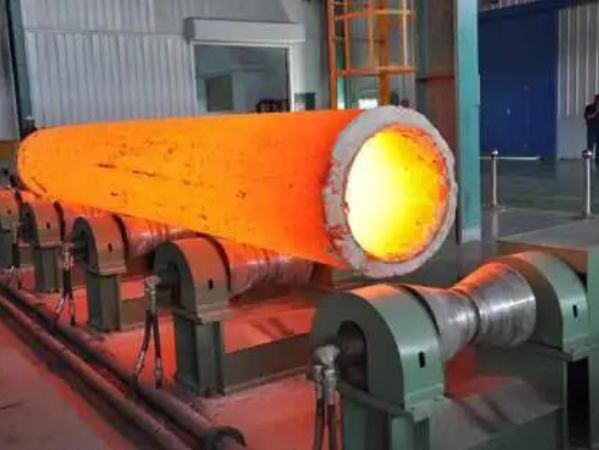Perforation is the first process of deformation of
hot-rolled seamless pipe, and it is also one of the most important deformation processes. Its function is to perforate the solid tube blank into a hollow capillary tube. According to the deformation characteristics of the tube blank during the perforation process, it is divided into longitudinal rolling There are two types: perforation and cross-rolled perforation.
Regardless of the type of perforation used, quality defects may occur. One type is caused by the defects of the tube itself or the defects of the tube during the heating process. The defects further expand after the tube is perforated; the other type is caused by the perforation process, which is due to incorrect design or adjustment of perforation process parameters and perforation. It is caused by reasons such as unreasonable tool shape and quality defects on the surface of the perforation tool.
Different piercing machines and different piercing methods have different causes of quality defects in the capillary tubes. The main quality defects of perforated capillary tubes include: uneven wall thickness of capillary tubes, inner straight channels, outer straight channels, surface scars and scratches, inward folds, outward folds and separation layers, etc.

1. Seamless pipe longitudinal rolling and perforation technology and quality defects and their prevention
Longitudinal rolling piercing includes pressure punching and push-rolling piercing. The defects caused by this piercing process are related to the inherent defects of the process itself, the quality of the piercing tool and improper operation. They mainly include the wall thickness of the punched (pierced) hole blank. Even, inside straight track, outside straight track, surface scratches, etc.
The wall thickness of the punching (piercing) hole blank is uneven: The main reason is that the punching (piercing) hole process itself can easily cause the center line of the punching (ejector) rod to deviate from the center line of the tube blank, thereby causing the punch (ejector) hole to be punched out. The inner hole of the punching (piercing) hole blank is eccentric; secondly, under the action of the huge punching force (back thrust), the punch (ejector pin) connecting the punch (head) will bend, and its tail end will also bend. The resulting deflection;
Precaution:
A. It is necessary to ensure that the tube blank is heated evenly to prevent serious burning damage, so as to eliminate the uneven wall thickness of the punched (pierced) hole blank caused by the poor heating quality of the tube blank;
B. Try to use the center line of the tube blank to coincide with the center line of the punch (ejector pin);
C. Prevent the punch (ejector pin) from bending. If bending is found, replace it in time.
Punching (piercing) inner and outer straights of the hole blank: Mainly caused by scratches on the inner surface of the punch (head) during relative motion with the inner surface of the tube blank. In order to prevent the inner and outer straight defects of the punched (pierced) hole blank, the cooling of the punch (punch) and die (roller) should be strengthened. Once the punch (punch) and die (roller) are found to stick to steel, they must be repaired and repaired in time. replace.
2. Cross rolling and piercing process and quality defects and their prevention
The cross-rolled perforation process is the most widely used in the production of seamless steel pipes and was invented by the German Mannesmann brothers in 1883. Cross-rolling piercing machines include two-roller cross-rolling piercing machines and three-roller cross-rolling piercing machines. The quality defects of capillary tubes caused by cross-rolling and perforation of tube blanks mainly include inward and outward folding of capillary tubes, uneven wall thickness and surface scratches.
Capillary tube folding in: Capillary tube is the most common defect in cross-rolling and piercing. It is closely related to the piercing performance of the tube blank, the adjustment of the piercing process parameters of the piercing hole type machine and the quality of the piercing head. Inward folding The factors that affect the inward folding of the capillary tube are: first, the amount of reduction (rate) and number of compressions before the plug; second, the hole shape; third, the surface quality of the plug.
Capillary tube outward folding: Capillary tube outward folding is mostly caused by surface defects of the tube blank. It is another surface quality defect that is easily caused when the tube blank is cross-rolled and perforated. Factors affecting the external folding of the capillary tube: A. The plasticity of the tube blank and the amount of piercing deformation; B. The surface defects of the tube blank; C. The quality of the piercing tool and the hole shape;
Uneven capillary wall thickness: There are uneven transverse wall thickness and uneven longitudinal wall thickness. Uneven transverse wall thickness is most likely to occur during cross-rolling and perforation. The main factors that affect the uneven transverse wall thickness of the capillary tube are: the heating temperature of the tube blank, the centering of the tube end, the hole type adjustment of the punching machine and the shape of the tool, etc.
Go here to learn more about " seamless vs welded pipe"


